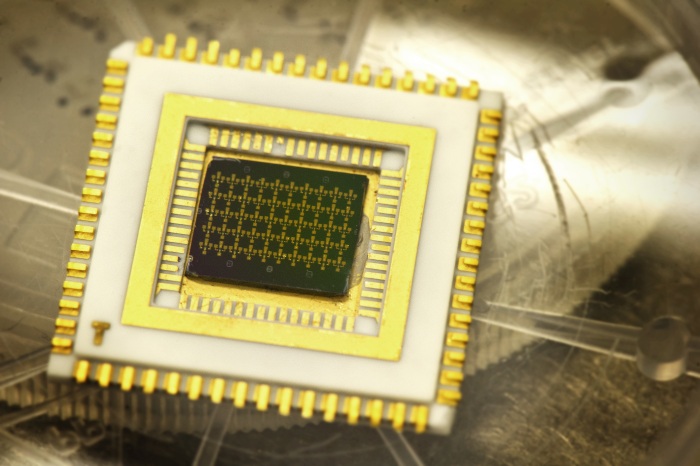Researchers at the University of Texas (Arlington) have made a discovery that could yield major technical benefits for the electronic devices industry. They’ve figured out how to cool electrons to a temperature of -380°F without any external means and at room temperature.
This means electronic devices could function using very little energy.

This chip contains nanoscale structures that enable electron cooling at room temperature.
Full details of the group’s research can be found in the article ““Energy-filtered cold electron transport at room temperature,” which is published in Nature Communications .
“We are the first to effectively cool electrons at room temperature. Researchers have done electron cooling before, but only when the entire device is immersed into an extremely cold cooling bath,” said Seong Jin Koh, an associate professor at UT Arlington in the Materials Science & Engineering Department, who led the research. “Obtaining cold electrons at room temperature has enormous technical benefits. For example, the requirement of using liquid helium or liquid nitrogen for cooling electrons in various electron systems can be lifted.”
Koh goes on to explain how electrons are thermally excited even at room temperature. If that excitation can be suppressed, then the temperature of those electrons could be lowered without external cooling.
To accomplish this, the team used a nanoscale structure consisting of a sequential array of a source electrode, quantum well, tunneling barrier, quantum dot, another tunneling barrier, and a drain electrode. When the electrons passed through the quantum well, their excitation — if you will — was suppressed, which, in turn, made them cool.
Cold electrons are a relatively new goal for researchers. Many believe they promise a new type of transistor that can operate at very low energy consumption.
“Implementing our findings to fabricating energy-efficient transistors is currently under way,” Koh added.
Usha Varshney, program director in the National Science Foundation’s Directorate for Engineering, which funded the research, said the research findings could be vast. “When implemented in transistors, these research findings could potentially reduce energy consumption of electronic devices by more than 10 times compared to the present technology,” he explained. “Personal electronic devices such as smartphones, iPads, etc., can last much longer before recharging.”
Ultimately, the goal is to keep the electron from gaining energy as it travels across device components. Further down the road, researchers will likely look into identifying key elements of this new cooling process to see if electrons can be cooled even more. Figuring out a solution in this regard will likely require research into how energy-gaining pathways could be effectively blocked.
Story via UTA
Advertisement
Learn more about Electronic Products Magazine





